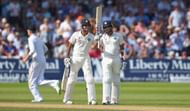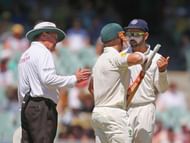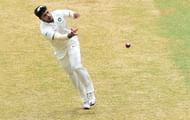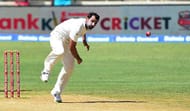As times change, sport changes too - an important reason why we love sport. It reflects the day and age. Indian cricket has gone through a paradigm shift over the last 25 years. Watching the present series under the captaincy of Indian cricket’s poster-boy, Virat Kohli, could be an overwhelming experience for any cricket enthusiast who has survived the torment called Indian cricket through the 90s.
Yes, India did have their moments back then. However, on a wide array of factors, the team lagged massively behind the super-power teams like Australia and South Africa. The last two decades have witnessed the meteoric rise of Indian cricket and BCCI, buoyed by massive crowds and the large market potential cricket has in India. There has been an attitudinal shift amongst the players and that shows in the way India competes now, win or no win, especially at home, where they are nigh insurmountable.
Here are five massive changes the 90s fan will be exhilarated about.
#1 Fielding standards especially of bowlers
On Day 2 of the second Test in Vizag, Jayant Yadav chased down a ball quickly, dived and released the throw with his body in the air, all the way from deep square leg. Saha collected the ball a meter away from the stumps and flicked it back, catching Hameed inches short of the crease.
Everything changed from there. Hameed and Root were going beautifully until that moment but that wicket started a mini-collapse that eventually cost England the match.
Both the Indian pacers, Shami and Umesh Yadav are quick on the field too. Yadav is particularly athletic and dives around in the outfield quite a bit. Ravindra Jadeja is probably one of the finest fielders in the world.
Ashwin is the only slow-mover amongst the bowlers and he isn’t really like the gangly pathetic bowler-fielders India used to have back in the 90s. It helps that most of the outfields in India are now lush-green ensuring that the new generation of cricketers inculcate the right habits.
#2 Batting contribution from bowlers

There was a time during the 90s when India had six batsmen to score all the runs. Very little was expected from the bowlers or even the wicket-keeper. Kapil Dev did well as an all-rounder and Manoj Prabhakar managed to contribute with the bat in a few games but India, by and large, had a genuine tail-ender problem. That changed in the 2000s as a higher premium was placed on bowlers who could bat a bit. The contributions from the lower order have been telling off-late.
Ashwin has even managed to move up to No.6 in the batting order. Ravindra Jadeja, someone with a triple century in domestic cricket, bats at No.8. Jayant Yadav scored 35 and 27* batting at No.9 on debut in the second Test at Vizag, crucial runs in the context of the match. The last three wickets added 92 runs for India in the first innings of the second Test.
In the second innings, the tenth-wicket partnership between Jayant Yadav and Mohammed Shami was 42 runs, pushing an otherwise surmountable target just out of England’s reach, as it breached the 400 mark. That managed to deflate the England batsmen as they began their fourth innings purely with an intention to survive.
#3 Two genuine quicks bowling in tandem
On the fifth day of the second Test, when everyone was expecting Ashwin and the other spinners to pick all the wickets, it was Shami who picked up the big fish, Joe Root, with a ball that curled in beautifully with pace, trapping the batsman LBW.
In the first innings, Shami broke Alastair Cook’s off-stump - a rare sight for an Indian fast bowler. Umesh Yadav got the crucial wicket of Jonny Bairstow in the first innings with a yorker that flattened the batsman’s stumps; both Yadav and Shami cross 140kph with ease.
Shami swings the ball at pace while Yadav managed to touch 148kph a few times in this series. Average speeds like these are unheard of in Indian cricket. India has never had two fast bowlers capable of bowling at 90 mph consistently, thereby picking wickets with the old and the new ball even on sub-continental pitches, even on a fifth day track. That is a great fillip indeed.
#4 Aggressive body language

A lot of this has got to do with the skipper Virat Kohli and the mindset inculcated by Sourav Ganguly. It is hard to keep Kohli quiet, or out of the game. He has the swagger and the talent to back it up, and most importantly, his ebullience rubs off on the other players.
Gone are the days when Indian fast bowlers were abused and sledged by the batsmen Down Under and in England. Indian players now are a noisy bunch constantly chirpy, athletic on the field and persistent. They heckle the umpires more now than they did back then.
While care should be taken by the coach Anil Kumble to make sure they don’t turn into an unruly bunch like the Australians of the late 2000s, the aggression is not such a bad thing. A similar aggression won Kohli many fans when India toured Australia couple of years back. All Indian cricket needs now is some wins outside the sub-continent.
#5 More than a couple of wicket-taking bowlers
No great team was ever built with just one or two great batsmen and just one or two great bowlers. The best teams always have more than a couple of bowlers capable of dislodging top-order batsmen. India currently has several of them.
While they do boast of Ashwin, the ICC No.1 ranked bowler, Shami, Yadav and Jadeja are all lethal under a variety of conditions. Shami and Yadav have pace and natural swing and it was heartening to see them, like Michael Atherton later pointed out, out-swing the English bowlers.
Reverse swing can be a huge factor on tracks where there is very little lateral movement. Kohli has at his disposal a bench of bowlers who could pick wickets in a variety of conditions. Good problem to have!
Follow IPL Auction 2025 Live Updates, News & Biddings at Sportskeeda. Get the fastest updates on Mega-Auction and cricket news



